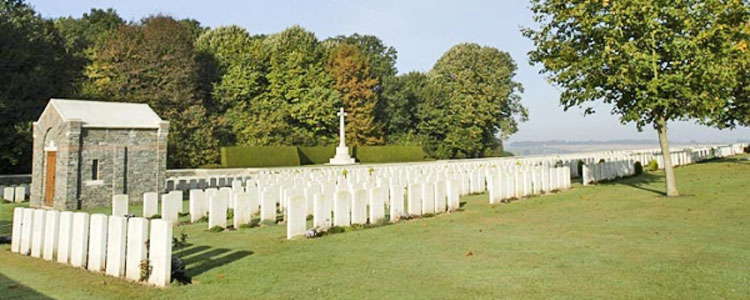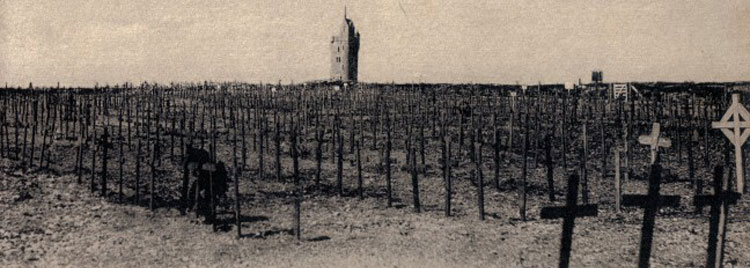 |
|
|
| Region : |
Thiepval, Somme, France |
| Latitude : |
50.058835 |
| Lontitude : |
2.680383 |
| CWGC Link : |
58600 |
| Thiepval is a village about 8 kilometres north-east of Albert. The Cemetery (signposted in the village) is on the edge of Thiepval Wood near the Ulster Tower, about one kilometre north-west of Thiepval on the Thiepval-Hamel road (D73). |
|
View Full Screen in Google Maps |
| No |
|
|
Rank |
Name |
Service No |
Regiment / Service |
Date Of Death |
Grave Ref |
|
| 1 |
|

|
Pte. |
Gilmour, James
|
21087 |
Royal Inniskilling Fusiliers |
01/07/1916 |
Grave II-F-9 |
| 2 |
|

|
Pte. |
Hammond, Joseph
|
27994 |
Royal Inniskilling Fusiliers |
01/07/1916 |
Grave III-B-1 |
| The German Army took the area around Thiepval at the end of September 1914. It then established a line through the area with troops from its 26th Reserve Division. Men from this Division were still in occupation when Commonwealth forces launched their assault on the 1 July 1916.
|
| During this attack, the 36th (Ulster) Division were detailed to attack the German positions north of Thiepval, known as the Hansa Line and the Schwaben Redoubt. Launched from Thiepval Wood, initially their assault was successful and some leading elements even reached as far as the German's second line of defence (Stuff Redoubt).
|

|
| However, by the end of the day, as a result of the units on either side of it failing to take their objectives (in particular the 32nd Division's failure to take Thiepval), it had been forced back to the original German front line.
|
| It would take until the 26 September 1916, before Thiepval finally fell to the 18th Division. Thiepval then remained under Allied occupation until 25 March 1918, when it was lost during the great German offensive, but it was retaken on the following 24 August by the 17th and 38th (Welsh) Divisions.
|

|
| Connaught Cemetery was begun during the early autumn of 1916 and at the Armistice it contained 228 burials (the whole of Plot I except 10 graves). It was then very greatly increased when graves were brought in from battlefields in the immediate area and the following small cemeteries:-
|
 THIEPVAL VILLAGE CEMETERY, on the summit of the ridge, West of the road to Grandcourt. It contained the graves of 215 British soldiers who fell in 1916 (or in a few cases in 1918).
THIEPVAL VILLAGE CEMETERY, on the summit of the ridge, West of the road to Grandcourt. It contained the graves of 215 British soldiers who fell in 1916 (or in a few cases in 1918).
|
 THIEPVAL VALLEY CEMETERY, on the South-East side of Thiepval Wood, contained 11 British graves.
THIEPVAL VALLEY CEMETERY, on the South-East side of Thiepval Wood, contained 11 British graves.
|
 QUARRY PALACE CEMETERY, THIEPVAL, close to the river and a little North-East of the hamlet of St. Pierre-Divion, contained 23 British graves of the autumn of 1916-17.
QUARRY PALACE CEMETERY, THIEPVAL, close to the river and a little North-East of the hamlet of St. Pierre-Divion, contained 23 British graves of the autumn of 1916-17.
|
 ST. PIERRE-DIVION CEMETERY No.1, THIEPVAL, a little South-East of that hamlet contained 10 British graves of November, 1916.
ST. PIERRE-DIVION CEMETERY No.1, THIEPVAL, a little South-East of that hamlet contained 10 British graves of November, 1916.
|
 DIVION ROAD CEMETERY No.2, THIEPVAL, almost adjoining St. Pierre-Divion Cemetery No.1 contained 60 British graves of July, August and September, 1916.
DIVION ROAD CEMETERY No.2, THIEPVAL, almost adjoining St. Pierre-Divion Cemetery No.1 contained 60 British graves of July, August and September, 1916.
|
 SMALL CONNAUGHT CEMETERY, THIEPVAL, opposite Connaught Cemetery, across the road. It was made by the 11th Division in November, 1916, and contained the graves of 41 British soldiers who fell for the most part on the 1st July.
SMALL CONNAUGHT CEMETERY, THIEPVAL, opposite Connaught Cemetery, across the road. It was made by the 11th Division in November, 1916, and contained the graves of 41 British soldiers who fell for the most part on the 1st July.
|
 BATTERY VALLEY CEMETERY, GRANDCOURT, 800 metres South-West of that village, contained 56 British graves of November and December, 1916, and one of July, 1917.
BATTERY VALLEY CEMETERY, GRANDCOURT, 800 metres South-West of that village, contained 56 British graves of November and December, 1916, and one of July, 1917.
|
 PAISLEY HILLSIDE CEMETERY, AUTHUILE, on the South side of Thiepval Wood, alongside Paisley Avenue Cemetery, and named from the same trench. It contained 32 British graves of July and August, 1916, mainly of the 49th (West Riding) Division.
PAISLEY HILLSIDE CEMETERY, AUTHUILE, on the South side of Thiepval Wood, alongside Paisley Avenue Cemetery, and named from the same trench. It contained 32 British graves of July and August, 1916, mainly of the 49th (West Riding) Division.
|
 GORDON CASTLE CEMETERY, AUTHUILE, just inside the South border of Thiepval Wood. It contained 33 British graves (26 belonging to the 49th Division) of July-September, 1916 and the grave of one French soldier who fell in October, 1914.
GORDON CASTLE CEMETERY, AUTHUILE, just inside the South border of Thiepval Wood. It contained 33 British graves (26 belonging to the 49th Division) of July-September, 1916 and the grave of one French soldier who fell in October, 1914.
|
 BLUFF CEMETERY, AUTHUILE, 800 metres North of Authuile village, contained 43 British graves of July and September, 1916. The vast majority of the burials are those of officers and men who died in the summer and autumn of 1916.
BLUFF CEMETERY, AUTHUILE, 800 metres North of Authuile village, contained 43 British graves of July and September, 1916. The vast majority of the burials are those of officers and men who died in the summer and autumn of 1916.
|

|
| There are now 1,268 Commonwealth servicemen of the First World War buried or commemorated in the cemetery. Half of the burials are unidentified, but special memorials commemorate two casualties believed to be buried among them and five buried in Divion Wood Cemetery No.2, whose graves could not be found on concentration. The cemetery was designed by Sir Reginald Blomfield.
|
|
|
|